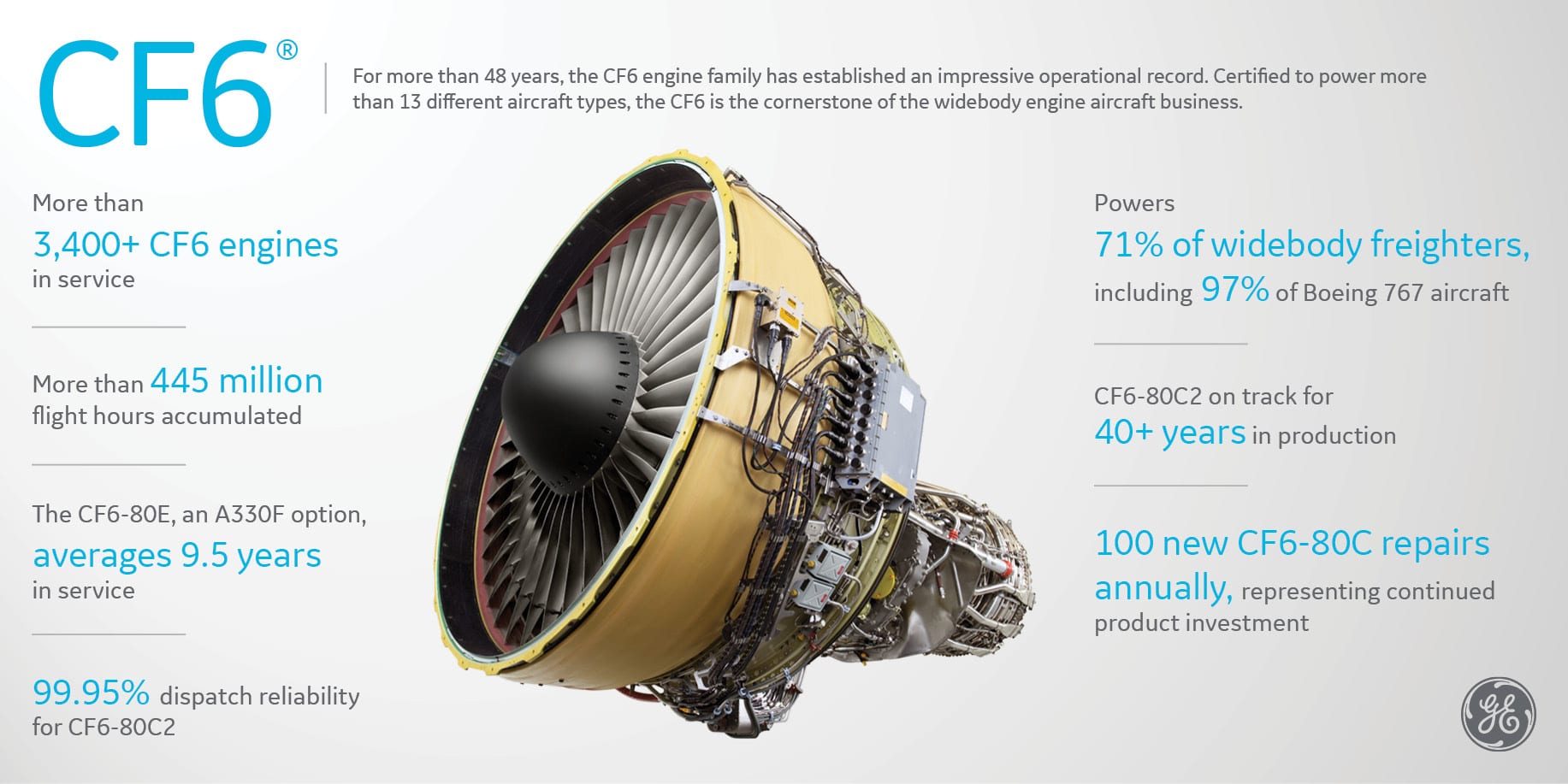CF6 Production Still Strong 50 Years After Paris Air Show Debut
June 17, 2019 | by Chelsey Levingston
Now considered a workhorse of the commercial aviation industry, the CF6 engine family that would make GE Aviation a contender in the civil aviation market was still in development at the 1969 Paris Air Show.
On the Le Bourget airfield 50 years ago, following tense negotiations and nervous nail biting, Brian Rowe, then the CF6 program manager, marketing manager Ed Hood and GE Aviation’s top executive Gerhard Neumann celebrated the sale of CF6-50 engines to their first European customer, the airline consortium KSSU.
What they couldn’t have anticipated then was where the engine program would be now, at the time of the 2019 Paris Air Show. The CF6 engine series is not only still flying, production is growing to power another new aviation market: ecommerce and air cargo. IATA’s 5-year air cargo forecast calls for global Freight Tonne Kilometers (FTK) flown to grow an average 4.4 percent a year.
The CF6 program was launched in 1967, celebrated sales to U.S. airlines in 1968 and European airlines in 1969, and the CF6-6 entered service on the McDonnell Douglas DC-10 application in 1971. GE Aviation went from a military turbocharger manufacturer to confronting aviation’s “big leagues”—commercial air space—with high bypass turbofans carrying passengers across oceans.
“This engine family was the bedrock from which all of our commercial engines gained a reputation for performance and reliability around the world,” Brian Rowe wrote in his book The Power to Fly: An Engineer’s Life.
This year, the CF6 program will reach production of nearly 8,500 engines across all models—and manufacturing is not slowing down. Of that number of engines delivered to date, more than 3,400 engines are still in service.
New CF6 variants powering widebody cargo freight planes are extending the engine’s life cycle. To meet freight demand, annual production rates of the CF6-80C2, CF6-80E1 and CF6-80CK1F are expected to continue at approximately 60 engines a year through 2025 and beyond.
The CF6-80 fleet is expected to remain flying past 2050. It’s possible the engine could power new applications in the future. GE Aviation is winning CF6 orders from cargo operators who know they can count on the company’s product support, whether the engine just left the factory or has been flying for decades.
“We’re still committed to the product, investing in our Services network to support ongoing demand that increasingly shifts from passenger to cargo use,” said Scott Brensike, CF6 Program General Manager. “CF6 has become the preferred choice by cargo operators due to its low maintenance cost and reliability.”

On the Le Bourget airfield 50 years ago, following tense negotiations and nervous nail biting, Brian Rowe, then the CF6 program manager, marketing manager Ed Hood and GE Aviation’s top executive Gerhard Neumann celebrated the sale of CF6-50 engines to their first European customer, the airline consortium KSSU.
What they couldn’t have anticipated then was where the engine program would be now, at the time of the 2019 Paris Air Show. The CF6 engine series is not only still flying, production is growing to power another new aviation market: ecommerce and air cargo. IATA’s 5-year air cargo forecast calls for global Freight Tonne Kilometers (FTK) flown to grow an average 4.4 percent a year.
The CF6 program was launched in 1967, celebrated sales to U.S. airlines in 1968 and European airlines in 1969, and the CF6-6 entered service on the McDonnell Douglas DC-10 application in 1971. GE Aviation went from a military turbocharger manufacturer to confronting aviation’s “big leagues”—commercial air space—with high bypass turbofans carrying passengers across oceans.
“This engine family was the bedrock from which all of our commercial engines gained a reputation for performance and reliability around the world,” Brian Rowe wrote in his book The Power to Fly: An Engineer’s Life.
This year, the CF6 program will reach production of nearly 8,500 engines across all models—and manufacturing is not slowing down. Of that number of engines delivered to date, more than 3,400 engines are still in service.
New CF6 variants powering widebody cargo freight planes are extending the engine’s life cycle. To meet freight demand, annual production rates of the CF6-80C2, CF6-80E1 and CF6-80CK1F are expected to continue at approximately 60 engines a year through 2025 and beyond.
The CF6-80 fleet is expected to remain flying past 2050. It’s possible the engine could power new applications in the future. GE Aviation is winning CF6 orders from cargo operators who know they can count on the company’s product support, whether the engine just left the factory or has been flying for decades.
“We’re still committed to the product, investing in our Services network to support ongoing demand that increasingly shifts from passenger to cargo use,” said Scott Brensike, CF6 Program General Manager. “CF6 has become the preferred choice by cargo operators due to its low maintenance cost and reliability.”






